The dawn of Ukraine’s independence in 1991 seemed like a promising start for its newly-created Armed Forces.
The downfall of the Soviet Union left Ukraine with vast ground forces, air fleet, navy, and even a large nuclear stockpile at its disposal. The young nation found itself among the world’s strongest militaries. The path to regional leadership in Eastern Europe was very real.
But it never came about.
Economic and political troubles threw the Ukrainian military downhill at breakneck speed. Within a decade, the rampage of plundering and underfunding turned the Armed Forces into a gnawed skeleton, with a miserable officer corps looking for subsistence in civilian life.
The country’s darkest hour came in 2014 when the disorganized nation found itself almost defenseless against Russia’s sudden invasion in Crimea and Donbas.
The war also gave birth to a new drive to resurrect the neglected Armed Forces. The new military managed to rise again, rearm and embark on a future goal of joining NATO.
But the patriotic surge turned out short-lived. Recently, the military again allowed itself to start sliding into senseless, Soviet-style bureaucracy, causing it to hemorrhage its most dedicated and experienced veterans.
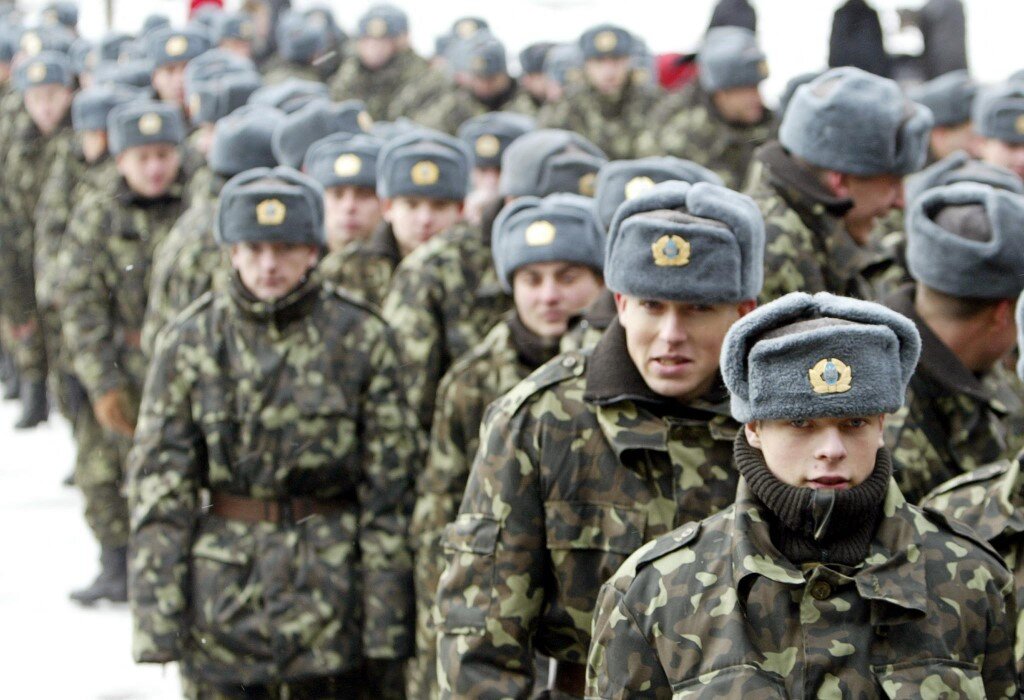
Ukrainian soldiers stand in a line to a polling station to cast their votes at the Desna military training range on Nov. 21, 2004. (AFP)
Soviet arsenal wasted
Independent Ukraine inherited staggering firepower from the dying Soviet Union.
This included nearly 980,000 personnel, 6,500 tanks, 7,000 personnel carriers, and infantry fighting vehicles, over 1,500 aircraft, 350 warships, and an extensive missile defense grid. That’s not to mention the 176 intercontinental ballistic missiles deployed across the country, carrying a total of 1,272 nuclear warheads, and also a stockpile of 2,500 tactical nuclear weapons.
This monster officially became the Armed Forces of Ukraine in late 1991. The Soviet heritage also made Ukraine the world’s 3rd most powerful nuclear nation, trailing behind only the United States and Russia.
The burden turned out much too heavy.
As early as in June 1992, Ukraine signed the Treaty on Conventional Armed Forces in Europe, which forced it to get rid of over 5,300 tanks, 2,400 vehicles, and 477 aircraft.
According to a Verkhovna Rada investigation into military embezzlement in 2004–2017, this opened the way to massive fire sales of Ukrainian hardware abroad, often at dirt cheap prices, for a total of nearly Hr 3.2 billion ($120 million).
Between 1992 and 2012 alone, over 1,100 tanks, 1,200 vehicles, 500 artillery pieces, 130 airplanes and 100 helicopters were sold off, mostly to African and Middle Eastern militaries. Nearly 80% of Ukraine’s arms production was also marked for export, often at the expense of Ukraine’s own military needs.
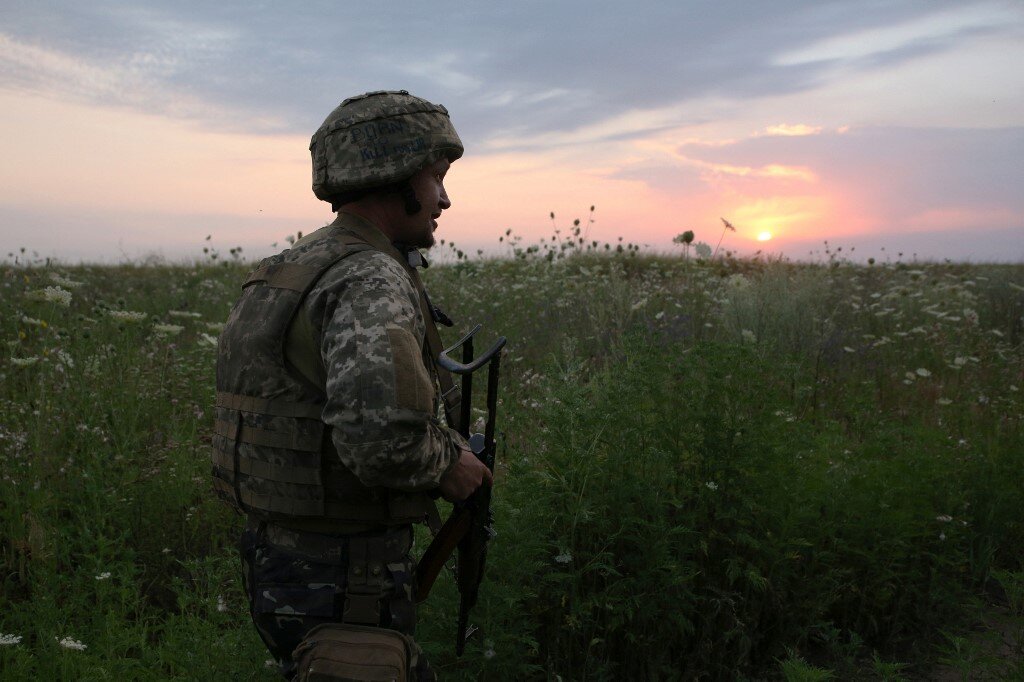
A Ukrainian soldier stands post near the small town of Krasnohorivka, in Donetsk oblast on July 21, 2021. (AFP)
The same was happening to the Armed Forces’ assets and real estate across the country.
But the military budget never saw the revenue from all these sales. In 1992, the Ukrainian military budget constituted 2.1% of the country’s gross domestic product. By the eve of Russia’s war in 2013, it fell to just 1%.
Severe budget cuts left hundreds of thousands of service members tossed aside. The military that started with over 900,000 personnel in 1991, had only 400,000 in 1992. By the time of the Russian invasion in 2014, it had only 120,900 active-duty service members — and, by some estimates, less than 5,000 combat-ready soldiers.
Those who decided to stay in the ranks had to cope with diminished training programs at all levels, as well as extremely poor maintenance and salaries. It was very common for military officers to find part-time jobs in civilian life or run small businesses to be able to provide for their families.
Some luckier Ukrainian soldiers had a chance to join peacekeeping missions that Ukraine used to run around the world — the Balkans, Iraq, Afghanistan, or Africa — fighting along with Western militaries.
Ukraine was also weakened by making deals with the Kremlin. According to the 1997 partition agreement, Kyiv accepted just 17% of the former Soviet Black Sea Fleet, although it officially shared the naval base of Sevastopol with Russia in Crimea.
Then, under its international commitments, Ukraine had to give up its strongest asset, its nuclear stockpile. By 1996, all of its nuclear weapons were eliminated or transferred to Russia, while its valuable Tupolev Tu‑95 and Tu‑160 strategic bombers were destroyed.
What Ukraine got in return was the ill-fated Budapest Memorandum of 1994 — under which the United States, the United Kingdom, and Russia offered their “security assurances” to Ukraine for it giving up on its nuclear status.
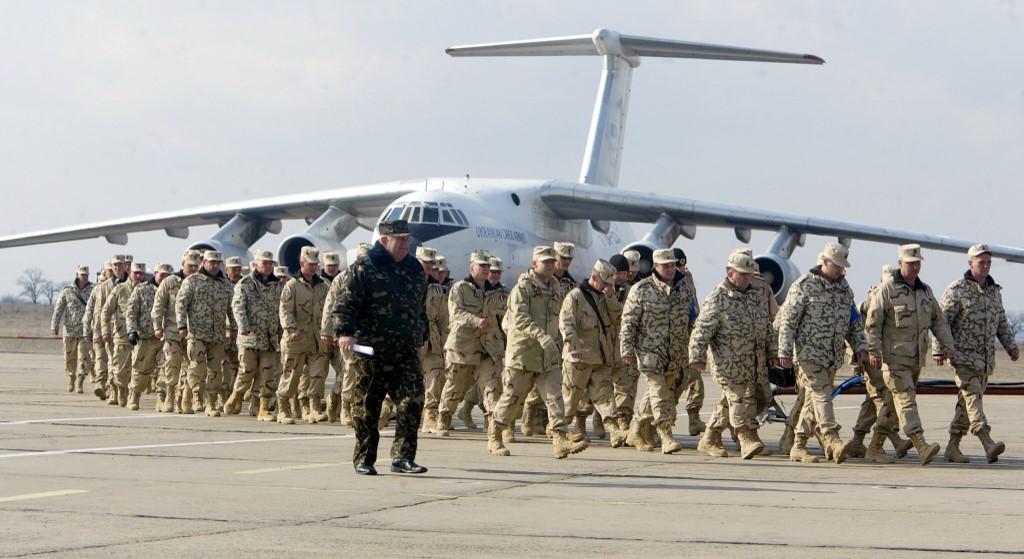
Ukrainian soldiers leave an Ilyushin Il-76 aircraft at the Mykolaiv airport on March 15, 2005, as Ukrainian forces withdraw from Iraq after a peace support mission launched in 2004. (AFP)
Disorientation
The 2010s were the worst years for the Ukrainian military.
Under President Viktor Yanukovych, the country’s leadership went from selling off military equipment to destroying the military chain of command.
According to the parliamentary investigation commission, in the early 2010s, the Armed Forces’ Joint Operative Command and Supporting Command were disbanded.
Experts said this completely derailed the military’s command, control, and maintenance system, as well as the country’s air defense grid.
By 2013, amid numerous structural transformations, all Ukrainian military formations deployed to the Crimean Peninsula were subjected to Naval Command — which turned out almost overwhelmingly loyal to Russia.
The outcome of that decision is now carved in history.
When unmarked Russian troops invaded Crimea in February 2014, the trapped and disoriented Ukrainian formations in the peninsula begged for orders. But no one was there to command them to defend against the invaders.
According to then-Defense Minister Ihor Teniukh, in the heat of Russian annexation, Ukraine was capable of sending no more than 5,000 combat-capable and loyal troops. Of the nearly 18,000 Ukrainian troops stationed in Crimea, only 4,000 refused to defect to Russia and fled to the mainland without a fight.
Ukraine effectively lost its Sevastopol base and nearly 85% of its naval power to Russia.
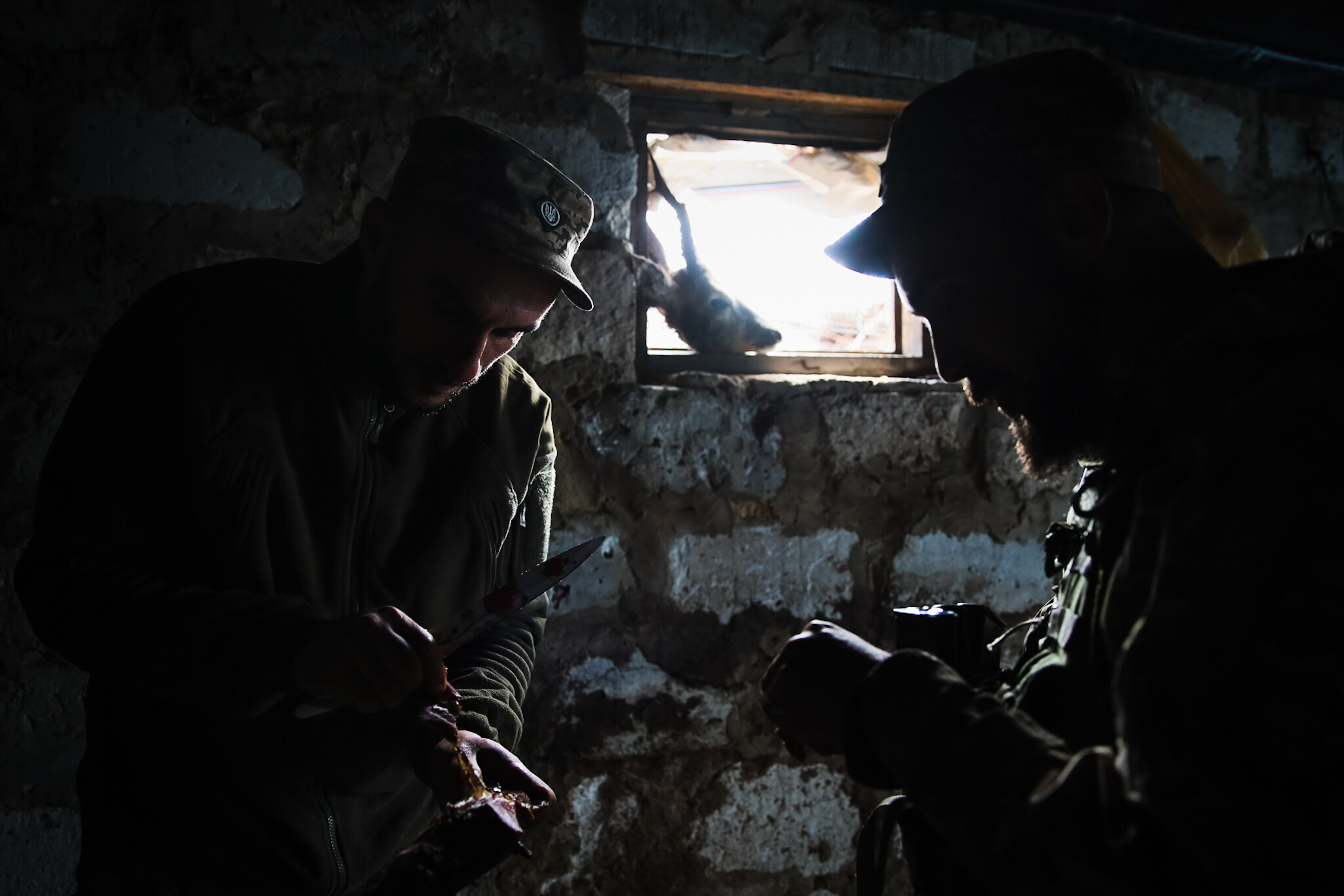
Ukrainian soldiers are seen near the Donbas war zone town of Zhovanka on April 28, 2021. (Volodymyr Petrov)
Rise again
Russia’s war in Donbas unfolded when the Armed Forces were only starting to come to their senses.
Few capable airborne and marine units — poorly equipped, relying heavily on civilian maintenance aid — joined the battle in the east along with scores of volunteering paramilitaries.
Pressed by the urgency to protect the country, the government launched extensive defense reforms. The Ukrainian military started to rise from ashes.
In spite of devastating defeats in the battles of Ilovaisk and Debaltseve in 2014 and 2015, the Ukrainian forces managed to deter the enemy inside Donetsk and Luhansk oblasts and stabilize the 420-kilometer front line it holds to this day.
Nearly 4,000 Ukrainian warfighters have perished in the battlefields of Donbas since 2014.
The Armed Forces, along with other security institutions, embraced a new grand policy of reaching full compatibility with NATO standards and shedding all Soviet-era practices. Thousands of new regulations and instructions have been introduced to drastically change the military functionality and turn it into a quality-driven, westernized force.
Under the new national security regulations, Ukraine has to spend at least 5% of its GDP on security, including 3% on the military. Thus, annual military budgets skyrocketed from Hr 26.9 billion ($1 billion) in 2014 to Hr 117.5 billion ($4.4 billion) in 2021.

President Volodymyr Zelensky kneels next to the graves of Ukrainian soldiers killed in battle on the front line of the war in the Donbas on the Armed Forces Day on Dec. 6, 2020. (Presidential Press Service)
The number of personnel in active service also increased, jumping from 165,000 in 2014 to 250,000 in 2020. President Volodymyr Zelensky’s initiative to create a nationwide territorial defense grid raised the manpower cap by 261,000.
The NATO rapprochement was a success as well. Apart from numerous joint drills, in June 2019, Ukraine’s 140th Special Operations Center was certified by the NATO Response Force. This was the first instance of a non-NATO formation being fully cleared for deployment with Alliance operations.
The Ukrainian military has considerably improved its maintenance, weaponry, its operational capability, and its organization thanks to extensive foreign aid. Since 2014, the U.S. alone has spent close to $2 billion to help Ukraine build up a new military, including modern lethal weapons.
However, according to multiple records, the military media’s optimistic reports cover a darker picture.
Starting in 2016, scores of Donbas soldiers and officers have been leaving the ranks in resentment. The patriotic surge of the early months of war has gone — what is now in the foreground is corruption, heaps of useless paperwork, and Soviet-style leadership.
While Ukraine has achieved immense military progress since 2014, as a country at war, it can’t afford to regress.
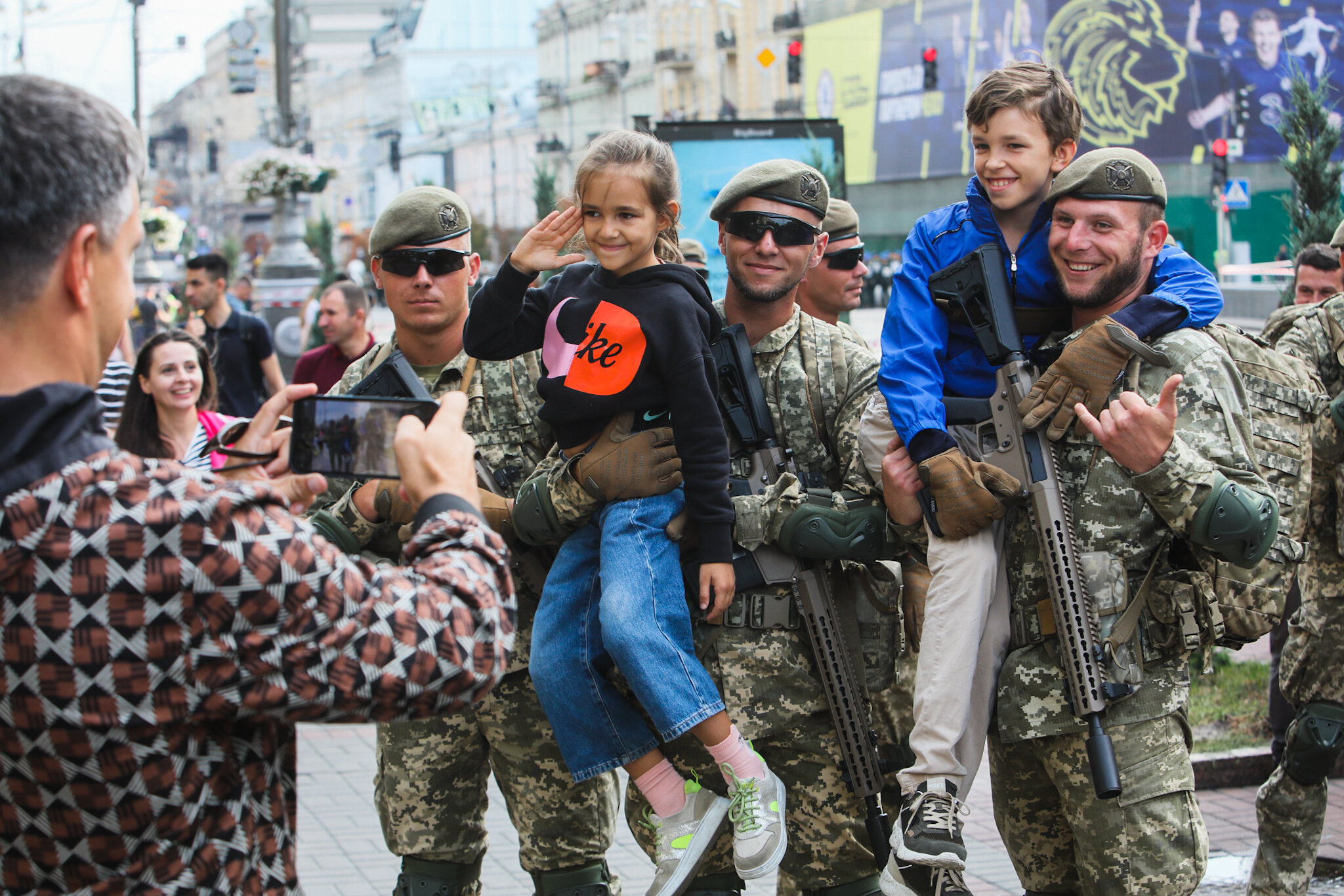
Ukrainian infantrymen pose for a picture with kids in Kreschatyk Street during a dress rehearsal to the 30th Independence Day Parade in downtown Kyiv on Aug. 18, 2021. (Volodymyr Petrov)
